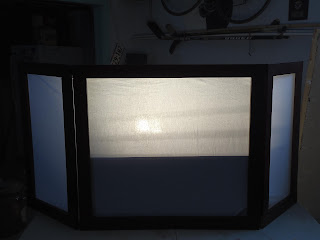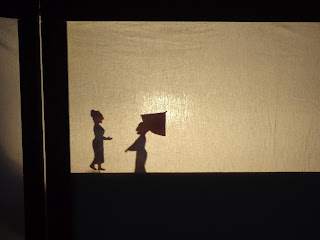 |
| Billy's version of Peter Pan, a seven stringed marionette. |
I managed to talk with the creator of the marionette for almost an hour and we spent the time discussing all aspects of his marionette. I tried to glean as much information as possible so that I could work on this next aspect of The Batty Puppeteers.
The Joints
From my closer inspection of Billy's marionette I was able to see how the joints of the legs and arms were pieced together. While this aspect of jointed marionettes had never eluded me, it was nice to see how somebody else had done it.
 |
| The leg joint of the marionette. |
 |
| The arm joint of the marionette. |
This version of Peter Pan does not move his neck about easily; he is quite stiff in that regards (no pun intended). I tried to take a picture of the neck area but none of the pictures came out well enough to post. This is something that we would want to examine further. The Batty Puppeteers' group vision has fully articulated marionettes; so the head would have to move about as freely as any normal actor's would.
The Hands
Traditional marionettes have always had relaxed hands. It wasn't until the resurgence of marionettes in the mid 1900's that different styles of hands or even controllable hands were used. However, for a medieval style marionette; the hand structure and style of Billy's Peter Pan is perfect.
 |
| The hand design of the marionette, a variation of the popular Czech marionettes. |
Stringing
The marionette that I saw at the Renaissance Faire had a simple string arraignment. In fact, I was all too familiar with this system as it is what we use on our current marionettes. Strings control the hands and the knees, two strings control the head movements, and one sting was attached to the marionettes backside. The "seven-stringed" method is perfect for beginning puppeteers as it is easier to work than the "nine-stringed" method.
The controller was a simple T-shaped controller. This style is simple and effective but somewhat foreign to me as we operate our marionettes with an "airplane" controller. However, for his first marionette, Billy's choice of controller was perfectly fine.
The Head
Billy confessed to me that the head was the hardest part for him to create. From my own experiences of extremely basic marionettes heads, I applaud his skill and ability for what he accomplished. Using a band saw to finish the main shape of the head, he then took chisel and knife to work out the additional features. The rough texture to the existing marionette adds medieval feeling to the whole project; which is what I feel the creator of this piece was working towards.
Clothing
The clothing worn by this marionette is made of felt and is not able to be removed from the marionette without detaching the string connection points and roughing up the marionette. This is the main problem that I see with our own future marionettes. The plan is to change costumes for different performances and the clothing or string connection points will have to be designed in such a way to allow clothing to be put on, added to, or taken off throughout the lifetime of the marionette.
Final Thoughts
Billy's marionette is a wonderful example of a Phase Three marionette for our troupe. The whole marionette, from the joints to the head, is a wonderful example of an early style stringed puppet. The close inspection that I was afforded has given me ideas of where to start and what parts of the process will need to be altered to fit our needs.




















